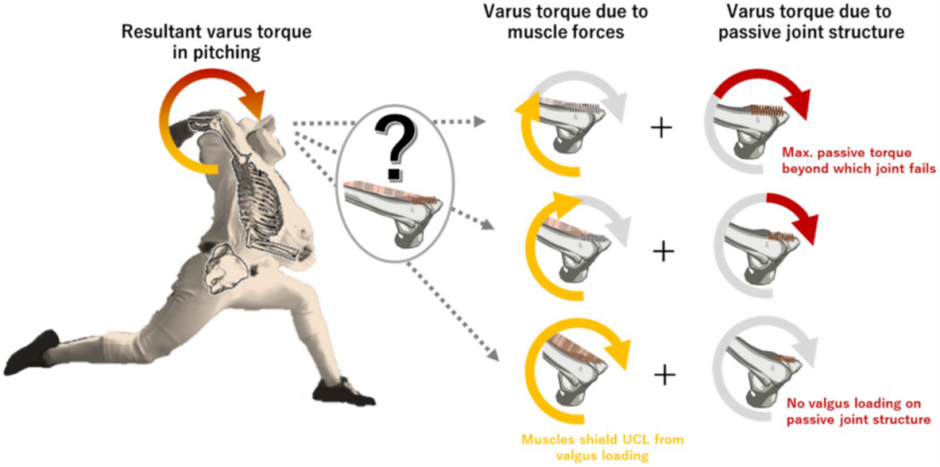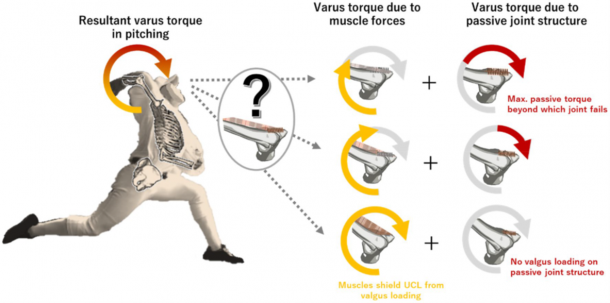- NEWS
- A novel method intersecting three‑dimensional motion capture and medial elbow strength dynamometry to assess elbow injury risk in baseball pitchers
A novel method intersecting three‑dimensional motion capture and medial elbow strength dynamometry to assess elbow injury risk in baseball pitchers

- Posted
- 2023年8月28日(月)
Abstract
In baseball pitching, resultant elbow varus torque reaches the peak value of 50–120 Nm, exceeding the joint failure limit that risks damage to the ulnar collateral ligament (UCL). In-vivo methodology is lacking to assess whether pitchers have sufficient muscular strength to shield UCL and how strongly the elbow musculature must contract to minimize valgus loading on UCL. This study introduces a method to assess relative percentages of muscular varus strength required to unload the UCL.

Research Background
The medial aspect of elbow joint is one of the most common sites of overuse injuries to baseball pitchers. The mechanism of medial elbow injury is centered on the UCL’s inability to withstand repeated valgus loading which opens the inner elbow compartment and causes elongation of the ligament that overtime can lead to attenuation and failure. Cadaveric studies have indicated that contractile forces of the muscles surrounding the medial aspect of elbow joint could produce a torque that counteracts the valgus loading to reduce the stress on the UCL. It is not yet known whether baseball pitchers’ elbow musculature is strong enough to eliminate valgus loading on the UCL and how strongly the musculature must contract to eliminate valgus loading on UCL or to reduce the loading to fall within the safe range.
Findings
The present method successfully assessed if baseball pitchers have sufficient muscular varus strength to withstand the valgus loading and how strongly the elbow musculature must contract to reduce the loading on the UCL to fall within safe range. For two model participants (post-operative professional baseball pitchers), the maximum resultant varus torque in pitching was found to range 72–97% of their respective maximum voluntary isometric varus strength (MVIVS) depending on the type of pitch. The elbow musculature had to produce 21–49%MVIVS to avoid acute failure of intact UCL whereas the corresponding requirements were 39–63%MVIVS for UCL reconstructed joint.
Development Method
1. An in-vivo method for measuring MVIVS.
2. A simulation model to determine the relative percentages of MVIVS required to unload the UCL to varying degrees.
Future issues
The methodological procedure presented in this study is generalizable whereas the quantitative data are not. Therefore, the discussion of the quantitative results should remain descriptive in nature although the outcomes of the extended theoretical analysis provide unique clinical implications beyond the cases. The quantitative findings need to be validated by future studies using large samples.
Researcher’s Comments
The method offers new insight into baseball pitcher’s training/rehabilitation and physical assessment to reduce the risk of UCL injury.
Journal Information
Journal:Scientific reports
Title of original paper:A novel method intersecting three‑dimensional motion capture and medial elbow strength dynamometry to assess elbow injury risk in baseball pitchers
Authors:Toshimasa Yanai (Waseda University), Kengo Onuma (Waseda University), Ryan Crotin (Louisiana Tech University), Daisuke Monda (Saitama Seibu Lions)
Article Publication Date:2023
URL:https://onlinelibrary.wiley.com/doi/epdf/10.1111/sms.14374
DOI: 10.1111/sms.14374
Research Grant
research grant :Japan Society for the Promotion of Science
research representative:Toshimasa Yanai
